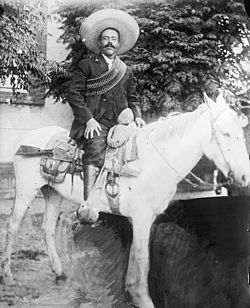Sombrero
Traditional Mexican folk hat From Wikipedia, the free encyclopedia
In English, a sombrero (Spanish for 'hat', lit. 'shadower'; Spanish: [somˈbɾeɾo]) is a type of wide-brimmed Mexican men's hat used to shield the face and eyes from the sun. It usually has a high, pointed crown; an extra-wide brim (broad enough to cast a shadow over the head, neck, and shoulders of the wearer) that is slightly upturned at the edge; and a chin strap to hold it in place.
 Various sombreros on display at the Museo de Arte Popular in Mexico City | |
| Type | Hat |
|---|---|
| Place of origin | Mexico |
In Mexico, this hat type is known as a sombrero de charro[1] ('charro hat', referring to the traditional Mexican horsemen). In Spanish, any hat is considered a sombrero.[2]
Design
Summarize
Perspective
Sombreros, like cowboy hats, were designed in response to the demands of the physical environment. High crowns provide insulation, and wide brims provide shade. Hot and sunny climates inspire such tall-crowned, wide-brimmed designs,[3] and hats with one or both of these features have evolved again and again in history and across cultures. For example, the Greek petasos of two millennia ago, and the traditional conical hat widespread in different regions of Asia – into modern times – incorporate such heat-mitigating features.[4] Designs specifically for riders on horseback with these details can be seen at least as far back as the Mongolian horsemen of the 13th century.[3][5]
Its precise evolution is unknown, but it is usually accepted that the Mexican-style sombrero's specific form arose amongst mestizo cowboys in Central Mexico.[3]: 11 One early style believed to be a forerunner of the Mexican sombrero form was a style worn by wealthy Spanish landowners of colonial-era Andalusia and Navarre.[6][better source needed] Although in English sombrero is usually understood to refer to the traditional Mexican headwear, the term sombrero predates this item of clothing, and has been applied to several differing styles of hat. Other types of hats known as sombrero can be found in South America and Spain. These include: the Spanish sombrero calañés from Huelva, sombrero cordobés of Córdoba, and sombrero de catite of Andalusia; and the Colombian sombrero vueltiao.
Cultural influence
Summarize
Perspective
Many early Texan cowboys adopted the Spanish and Mexican sombrero with its flat crown and wide, flat brim. Also called the poblano, these hats came from Spain.[6]
The Mexican variation of the sombrero added an even wider brim and a high, conical crown. These are the hats worn by mariachi musicians and charros. Both types of sombreros usually include a barboquejo or chin strap.[2]
In the Western United States, the sombrero had a high conical or cylindrical crown with a saucer-shaped brim, highly embroidered and made of plush felt.[7]
In the Philippines, due to the influence from Spain brought about by the Manila galleon trade, the term has been assimilated into the Tagalog language in the form of sumbrero and now refers to any hat – from Mexican sombreros (as used in the English language) to baseball caps.[8]
The galaxy Messier 104 is known as the Sombrero Galaxy due to its appearance.[9] Similarly, Tampa Stadium was also known as "The Big Sombrero". In mathematics, the Jinc function is sometimes called the sombrero function and in physics, the Sombrero potential is a prescription for the potential energy that leads to the Higgs mechanism.
- Mexican Escaramuza charra wearing sombrero in a chareada.
- An Apache chief with a sombrero
- Pancho Villa wearing a sombrero
See also
- Jarabe Tapatío, often referred to as the Mexican hat dance
- Ranch
- Vaquero
- Western wear
Other kinds of hats:
References
External links
Wikiwand - on
Seamless Wikipedia browsing. On steroids.



